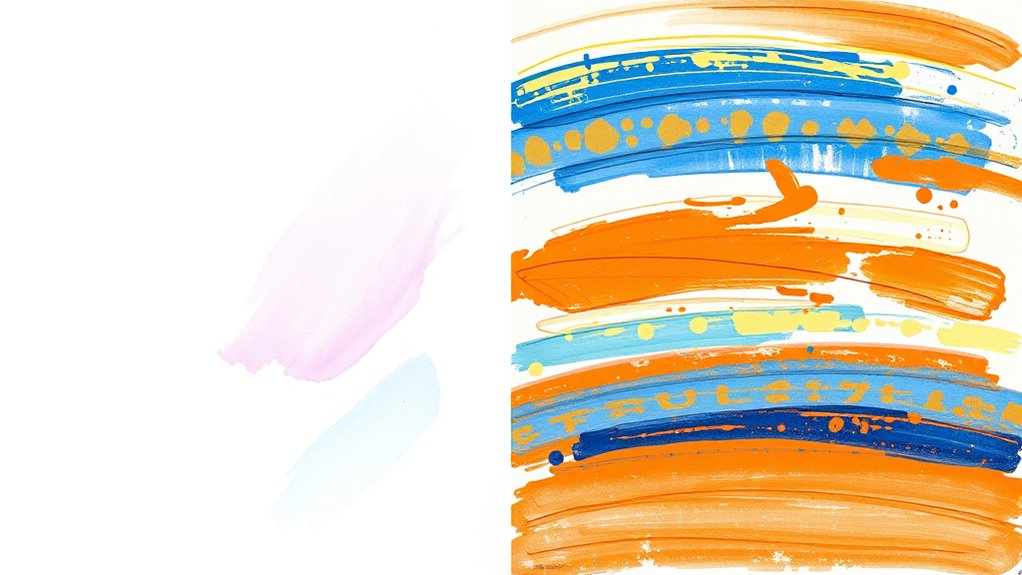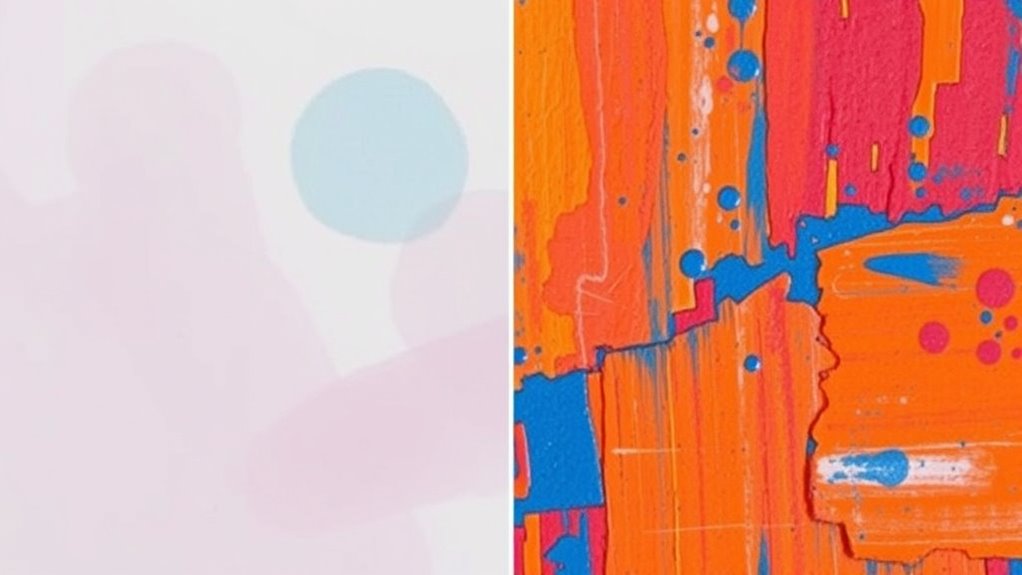Soft pastels give you a velvety texture that’s easy to blend and create delicate, luminous effects, making them great for capturing light and subtle shading. In contrast, oil pastels have a creamy, rich consistency that allows bold strokes and vibrant colors, with minimal smudging for better control. Both offer unique textures and finishes, so your choice depends on whether you prefer softness and subtlety or vibrancy and texture. Keep exploring to discover which medium suits your style best.
Key Takeaways
- Soft pastels offer velvety texture, easy blending, and delicate color transitions ideal for luminous, atmospheric artwork.
- Oil pastels have a creamy, rich consistency that produces bold, textured strokes with vibrant colors.
- Soft pastels are more forgiving and beginner-friendly due to their malleability and ease of blending.
- Oil pastels are less prone to smudging, allowing for precise details and layered, painterly effects.
- The choice depends on artistic goals: soft pastels for subtle, glowing effects; oil pastels for bold, textured expression.

Have you ever wondered how artists achieve that soft, luminous quality in their artwork? When it comes to pastel drawing, the choice between soft pastels and oil pastels substantially influences the final look. To understand this better, you should consider a techniques comparison and think about artist preferences. Soft pastels are known for their velvety texture, which allows for blending and layering that creates delicate, glowing effects. Artists who favor soft pastels often enjoy their ease of use, as they’re easily smudged and blended with fingers, blending tools, or even brushes. This flexibility makes soft pastels ideal for capturing subtle gradations of color and light, giving your artwork a luminous, almost ethereal quality. They’re also generally more forgiving for beginners, thanks to their malleability and forgiving nature.
On the other hand, oil pastels provide a different experience altogether. They have a richer, creamier consistency because of their oil content, which makes them less prone to smudging and easier to control for precise details. Artists who prefer oil pastels tend to appreciate their durability and vibrant color payoff. Unlike soft pastels, oil pastels don’t require blending for smooth transitions; instead, they can be layered thickly or smudged minimally to retain their boldness. This results in artwork with a more textured, almost painterly feel. For those interested in creating bold, expressive strokes with a substantial presence, oil pastels are an excellent choice.
Choosing between soft and oil pastels often hinges on your personal artist preferences and the effects you aim for. If you love working with delicate shades, smooth transitions, and a luminous finish, soft pastels might suit you best. They lend themselves well to capturing light and atmosphere, which is why many artists favor them for portraiture or landscape work. Conversely, if you prefer vibrant, intense colors with a more tactile, textured surface, oil pastels align more closely with your style. They’re excellent for producing thick, expressive strokes, making them popular among artists who enjoy a painterly approach.
Ultimately, your decision will depend on your artistic goals and the techniques you enjoy experimenting with. Both soft and oil pastels offer unique advantages, and exploring both can deepen your understanding of pastel drawing. For instance, some artists combine both mediums in a single piece to leverage their respective textural qualities and achieve complex effects. Whether you lean toward the gentle blending of soft pastels or the bold vibrancy of oil pastels, each medium has its charm. By trying out both, you’ll discover which techniques resonate with you most, helping you develop your own distinctive style that harnesses the luminous qualities of pastels.
Frequently Asked Questions
Which Pastel Type Is More Suitable for Beginners?
Soft pastels are more suitable for beginners because they allow easier pastel blending and pastel layering. You can effortlessly create smooth progressions and build up colors without much effort. Their easy-to-blend nature helps you practice shading and color mixing, making the learning process smoother. Oil pastels tend to be more difficult for novices due to their thicker consistency, but soft pastels give you the flexibility to experiment and improve your skills quickly.
How Do Pastel Drawings Compare to Pencil Sketches?
Imagine a world where textures tell stories—pastel drawings often offer richer textures and vibrant color blending than pencil sketches. Pastels allow you to blend colors seamlessly, creating luminous effects, while pencil sketches focus on precision and fine detail. If you crave bold, expressive visuals with tactile texture differences, pastels are your go-to. Pencil sketches suit delicate lines and subtle shading, but for dynamic color play, pastels truly stand out.
Can Pastel Art Be Preserved Long-Term?
Yes, your pastel art can be preserved long-term if you use proper conservation techniques. To guarantee longevity, store your artwork in archival materials like acid-free frames and protect it from light, humidity, and dust. Avoid touching the surface directly, and consider applying a fixative spray designed for pastels. By following these steps, you’ll help maintain the vibrancy and integrity of your pastel pieces for years to come.
What Surfaces Are Best for Pastel Drawing?
Choosing the right surface is like finding a dance partner for your pastel art. Textured surfaces, such as sanded paper or pastel boards, are ideal for color blending and holding your pigment. They prevent smudging and let your artwork shine with vibrant depth. When you work on these surfaces, you’ll enjoy smooth progressions and rich textures, making your pastel drawings both striking and long-lasting.
Are Oil Pastels More Versatile Than Soft Pastels?
Yes, oil pastels are more versatile than soft pastels because they offer a wider range of texture variations and blending techniques. You can create smooth, creamy effects or rough, textured surfaces by layering and blending differently. Oil pastels stay moist longer, allowing you to manipulate colors more easily and achieve richer, more vibrant results. This flexibility makes them suitable for various styles and techniques, giving you more creative control.
Conclusion
Now that you know the difference between soft and oil pastels, you’re ready to create stunning artwork. Whether you prefer the smooth blending of oil pastels or the vibrant, chalky finish of soft pastels, your artistic journey is just beginning. Remember, even Leonardo da Vinci would be impressed by your skills—just don’t forget to save your work before the next internet outage. Keep experimenting, and let your creativity shine brighter than a neon sign in Times Square!









